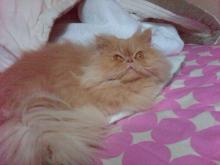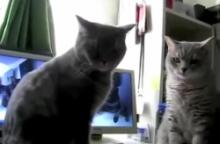Recently my husband built our cats their own play tower, completely cost-free for us (save for the time it took, which we don’t count, since he had fun making it). It was pretty simple to build, and he made it all out of scrap wood and scrap carpet. Here’s the breakdown of how to make one if you want to surprise your own cats with a tower.
Step 1. Assemble your supplies. You will need a full sheet of plywood, four 1 x 1 pieces of lumber, wood screws, and carpet nails. You’ll also need an electrical drill, a skill saw or table saw, and some carpet to cover your cat tower. (We used both scrap wood and carpet.) This will account for enough supplies for one tower with a roof and two cubbies for cats; you can reduce the supplies for a smaller tower and likewise increase them for a larger tower. However, more than three cubbies isn’t recommended, unless you can attach it to the wall for safety (use L-brackets or something similar for this), since the cats could knock it over! Also, this is a square tower (see photo), not a traditional round one.
Step 2. Measure your plywood to the desired length and width of your tower. Mark this with a pencil. Our tower is 3 feet tall and 1.5 feet by 1.5 feet in width, which is just big enough for our largest cat, who is about 11 or 12 pounds. If you have a larger cat, you might want to increase the width.
Step 3. Cut your 1 x 1 boards to your height selected. Using your wood screws, tack the 1 x. 1 boards to the plywood.
Step 4. Measure about halfway down the front and back pieces of plywood. Make marks for these measurements, then cut the 1x1 pieces width-wise to put in a divider.
Step 5. Tack the 1x1 boards in place where you made your marks.
Step 6. Find a cicular disc, such as a paint can, to use as a template for your front entrance holes. Cut these holes out in the center of each section, creating two kitty doors. (You may wish to cut these a bit larger if you have a larger cat.)
Step 7. Assemble the rest of your pieces together.
Step 8. Sand all of the rough edges down so kitty doesn’t get splinters!
Step 9. Tack the carpet on by tacking it with carpet nails. Cut off any excess.
Now you have a complete kitty tower to keep your cats amused! You can also hang dangling toys from the “ceilings” to keep him entertained.








